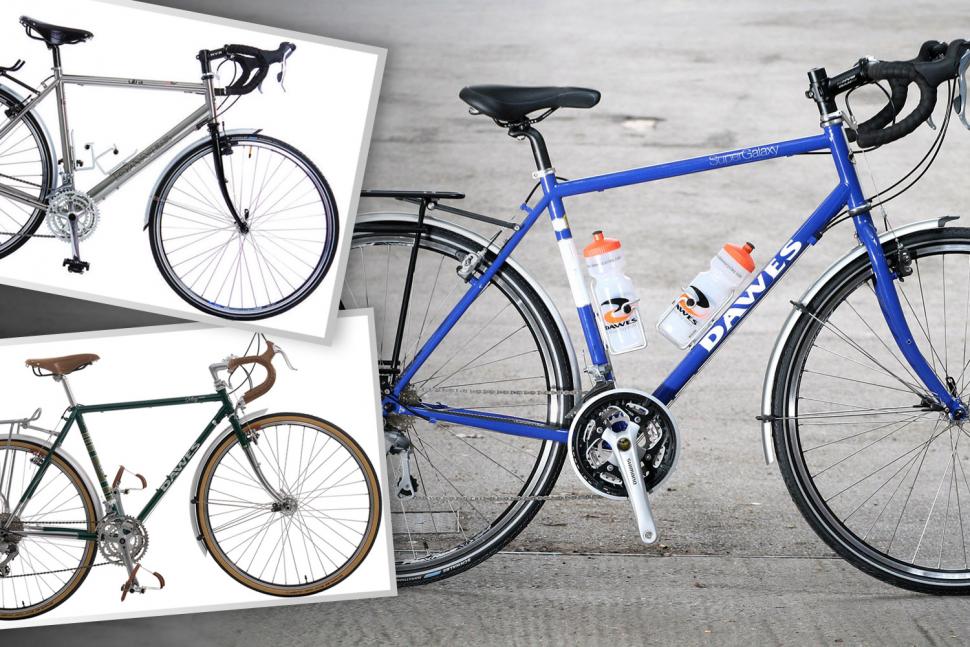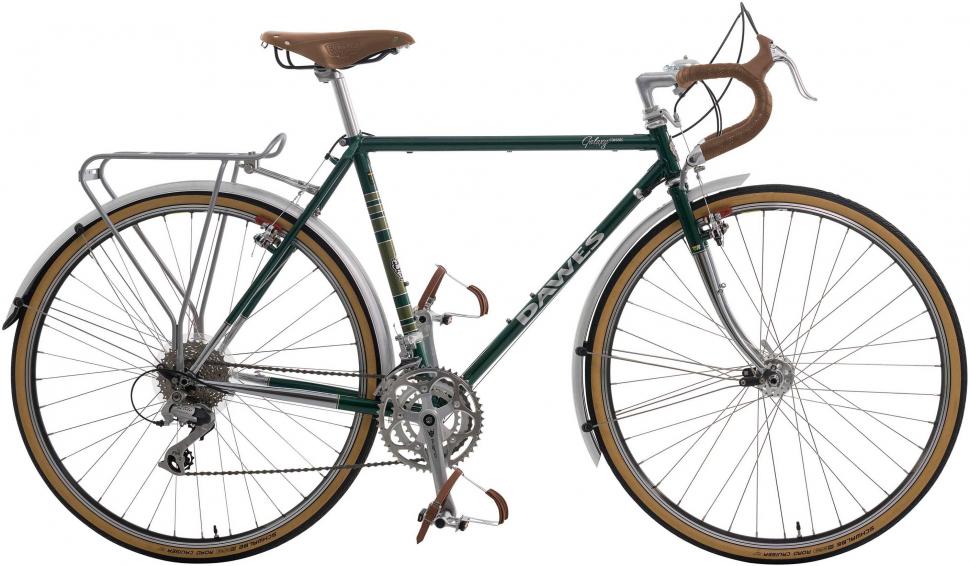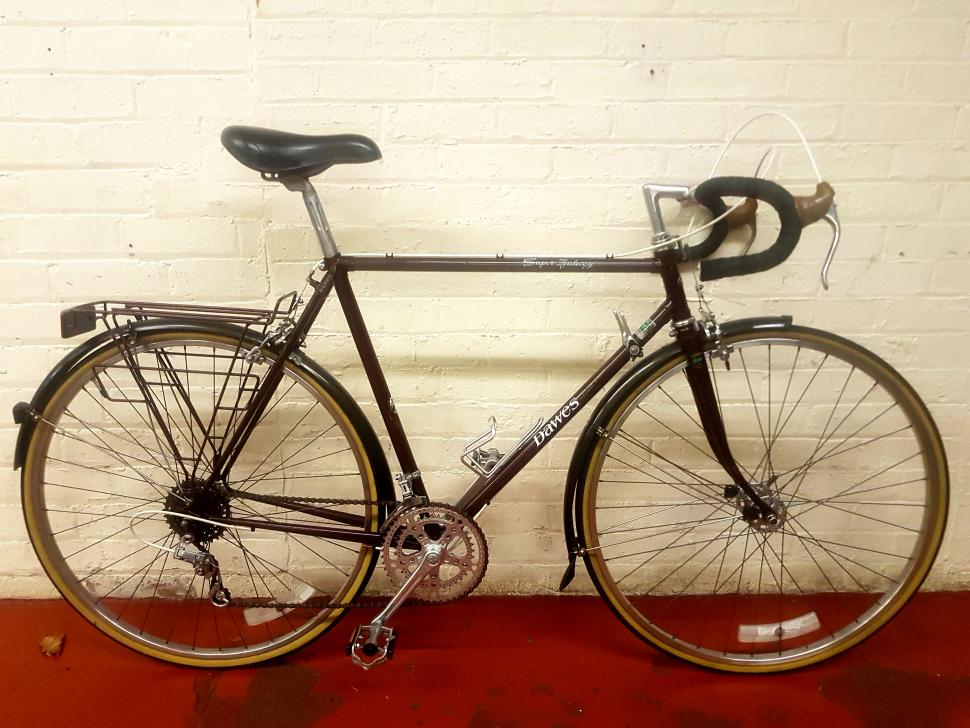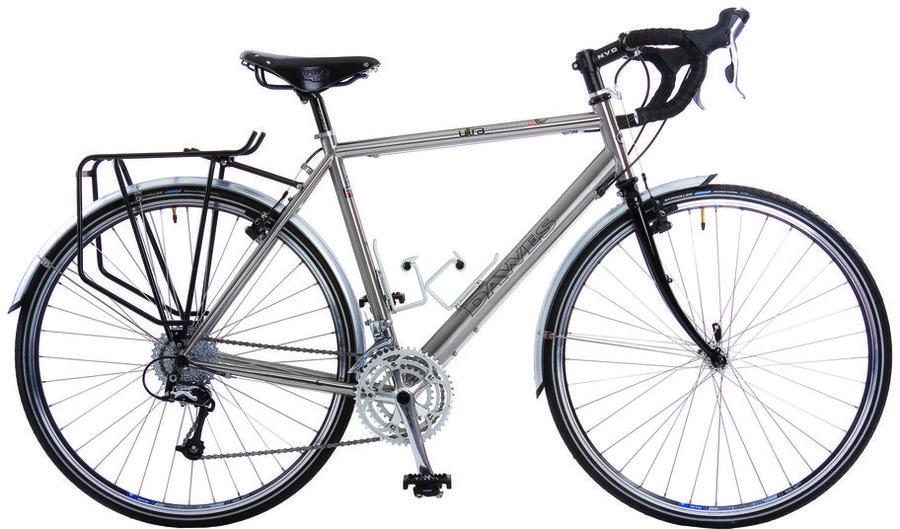- News
- Reviews
- Bikes
- Components
- Bar tape & grips
- Bottom brackets
- Brake & gear cables
- Brake & STI levers
- Brake pads & spares
- Brakes
- Cassettes & freewheels
- Chains
- Chainsets & chainrings
- Derailleurs - front
- Derailleurs - rear
- Forks
- Gear levers & shifters
- Groupsets
- Handlebars & extensions
- Headsets
- Hubs
- Inner tubes
- Pedals
- Quick releases & skewers
- Saddles
- Seatposts
- Stems
- Wheels
- Tyres
- Tubeless valves
- Accessories
- Accessories - misc
- Computer mounts
- Bags
- Bar ends
- Bike bags & cases
- Bottle cages
- Bottles
- Cameras
- Car racks
- Child seats
- Computers
- Glasses
- GPS units
- Helmets
- Lights - front
- Lights - rear
- Lights - sets
- Locks
- Mirrors
- Mudguards
- Racks
- Pumps & CO2 inflators
- Puncture kits
- Reflectives
- Smart watches
- Stands and racks
- Trailers
- Clothing
- Health, fitness and nutrition
- Tools and workshop
- Miscellaneous
- Buyers Guides
- Features
- Forum
- Recommends
- Podcast
TECH NEWS
 Dawes montage Nov 2020
Dawes montage Nov 2020Dawes ends Galaxy touring bike line after 49 years
Bike maker Dawes has discontinued the classic Galaxy range of touring bikes, bringing to an end a model that has been a favourite of touring cyclists since its introduction in 1971.
Gary Conway, senior product manager at Dawes parent company The Tandem Group, told road.cc in an email: "It’s with a heavy heart that the decision was made to discontinue the Galaxy range for 2021. Over the past few years sales have declined to a point where they were no longer feasible."
Cycle touring has always been a fairly small part of the cycling universe, and in the last few years the Galaxy must have come under considerable pressure from the new breed of gravel and adventure bikes and the trend of super-lightweight 'bikepacking'. If you can strap bags to any bike, why buy a dedicated tourer optimised for racks and panniers?
The Galaxy will be missed nevertheless. Conway says: "Typically however, since that decision was taken I’ve received numerous emails asking about the range and some very disgruntled members of the public who it seems had been saving up for years to finally bite the bullet and buy a Galaxy."
During its 49-year run, the Galaxy was available in a huge range of configurations. Early examples, like the 1984 model above, had frames in Reynolds 531 steel, centre-pull brakes and gear systems capable of being set up with very low ratios even if they didn't necessarily come that way.
Centre-pull brakes were necessary to reach round 1 1/4-inch tyres and mudguards but didn't actually work very well, and soon gave way to first cantilevers and then disc brakes. The mountain bike boom of the late 1980s made gear systems with triple chainsets available, and many Galaxy models through the 90s and on sported triples, like the Super Galaxy we tested in 2012.
While steel was the material of choice and tradition for most Galaxy models, there were aluminium-framed bikes at the cheaper end in the last few years and a luxury titanium version that cost a cool three grand in 2009.
There were Galaxy tandems too, a popular choice among tandemists whose budget didn't stretch to custom frames or high-zoot American models.
However, the Galaxy story might not be completely over.
"We do intend on bringing the Galaxy name back in a year or two," says Conway. In a way it's been yet another victim of the chaos of 2020. Bike suppliers are flat-out trying to keep current models in stock.
"Development is taking longer than usual while everyone is doing all that they can to keep up with demand on current models," says Conway.
John has been writing about bikes and cycling for over 30 years since discovering that people were mug enough to pay him for it rather than expecting him to do an honest day's work.
He was heavily involved in the mountain bike boom of the late 1980s as a racer, team manager and race promoter, and that led to writing for Mountain Biking UK magazine shortly after its inception. He got the gig by phoning up the editor and telling him the magazine was rubbish and he could do better. Rather than telling him to get lost, MBUK editor Tym Manley called John’s bluff and the rest is history.
Since then he has worked on MTB Pro magazine and was editor of Maximum Mountain Bike and Australian Mountain Bike magazines, before switching to the web in 2000 to work for CyclingNews.com. Along with road.cc founder Tony Farrelly, John was on the launch team for BikeRadar.com and subsequently became editor in chief of Future Publishing’s group of cycling magazines and websites, including Cycling Plus, MBUK, What Mountain Bike and Procycling.
John has also written for Cyclist magazine, edited the BikeMagic website and was founding editor of TotalWomensCycling.com before handing over to someone far more representative of the site's main audience.
He joined road.cc in 2013. He lives in Cambridge where the lack of hills is more than made up for by the headwinds.
Latest Comments
- Sredlums 2 sec ago
I'd say my 'constantly and tediously ranting against them' is a very tiny drop in an ocean of people, brands, marketeers, cycling media etc....
- Dnnnnnn 34 min 5 sec ago
I can see you've had a look at the Inverness Tourist Board Facebook page...
- Piratepete 43 min 40 sec ago
The Police Scotland Digital Evidence Sharing Platform being rolled out will not make it any easier to report incidents, it simply allows an...
- Rendel Harris 2 hours 40 min ago
Highway Code states: ...
- NR23Derek 3 hours 1 min ago
The video is there now
- open_roads 4 hours 7 min ago
It's great to see this sort of innovation but it's always worth reminding people who say helmets should be mandatory that most cycling fatalities...
- hawkinspeter 6 hours 43 min ago
I do indeed.
- Jakrayan 6 hours 52 min ago
The article states the toerags were youths, so unfortunately there probably won't be any real punishment. But at least the police are appealing for...
- David9694 7 hours 18 min ago
Residents awoken by car crashing into Almshouse garden...




Add new comment
17 comments
I've written a few words about my Dawes Galaxy because I love it so much. Hard to beat as an all-rounder. Bikepacking /gravel /cycle touring - call it what you will, the Galaxy (I've owned a couple) can do it all. #keepitsolidsteel
I've got a 2016 Galaxy Classic. Virtually identical to the first picture. I had to change the bars as they were absurdly narrow, even for a small bloke like me. It looks great and rides superbly, really smooth. I'm only selling it because the brakes are fucking awful but don't tell anyone, will you? 😜
Cantilever brakes can usually be made to work well, as long as the bosses are in the right position relative to the rim width and block thickness/reach. The trick is mostly in the straddle cable position (and block spacing if they're low profile brake arms). You also need to be sure you have good cables properly lubricated and good blocks (Kool Stop salmon by default). If you change from original components you also need to be sure that the lever pull matches the brake arms; too often someone will switch from traditional cantilever to direct pull brakes because they're suppposedly better, but retain the short pull levers, or vice versa - either will cause problems.
Centre pull brakes... didn't actually work very well? Bit of a surprise to me. By far superior to any single pivot side pull of the time for power and lack of rubbing, even if the modulation wasn't as good. If you actually wanted to stop a heavily laden bike (as opposed to slow down on something lighter) then a centre pull was the right choice. And if only for the proper centring, they were still better until dual pivot side pull came along in 1989.
Cantilevers offered more power and less weight if you could set them up properly, but the smaller radius of the pad travel meant pad wear ruined alignment.
I had a 1979 Holdsworth Mistral (similar to the Super Galaxy of the time) with Weinmann centre pulls, which carried panniers front and rear for shopping or camping trips; stopping with the original blocks was adequate but could get a bit exciting in the wet. Scott Mathauser brake blocks made a big difference, not only to stopping power in all weathers but also to modulation.
"We do intend on bringing the Galaxy name back in a year or two..."
Will that be like BMW did with "Mini" or VW did with the "Beetle"? Cos those reboots are just like the originals...
Given the popularity of anything retro these days, maybe it's just a matter of marketing. People can be strange, don't think much about it until the threat of losing it happens. Saw that here with fishermen, when Alvey (maker of traditional reels) announced they were closing down. The sudden influx of buyers forced a reversal of that decision, and now they're even running tv ads for the product.
Touring bikes are the great all-rounder, equally adept as a commuter or shopping bike. If they're not popular anymore, surely it must be due to buyers following fads rather than logic?
Alas, not all retro is popular. Riding with a lovely old 1980s steel Campag chainset marks you out as a connoisseur; but riding a 1980s Raleigh cottered crank would mark you out as miserable, impoverished, and quite possibly a masochist.
"Touring" seems to have an embarrassing old-fashioned image right now - but we've invented categories like "Bikepacking" and "Gravel" which do everything that Touring used to, but with the added attraction of carbon fibre and Instagram, and Dawes failed to capitalise on that trend. The retro niche is only going to be small, alas... maybe not enough to keep a whole brand afloat?
I agree Bob. Could be that Dawes brings back the Galaxy with a bikepacking / gravel makeover... which is essentially just slight modifications to the frame to accept wider tyres and adaptation to where the luggage can be strapped on. The StanforthConway is a remarkably similar bike to the Ultra Galaxy (which I own and have ridden all over the world).
My wife and I rode our matching blue '87 models (Reynolds 531 ST) on our JoGLE in 2010 and still use them for daily commuting duties. Mrs is still using hers as 2x6 with DT shifters, and even held a local QOM on it for a number of months! Mine is respaced for a 130mm rear and now running a triple 9 "Shimergo". Both fabulous machines, although especially in my 25-1/2" frame size they are not the stiffest machines. We also acquired a matching tandem of same vintage but it didnt see a great deal of use so we sold it on.
I had a Galaxy frame about 25 years ago. Solid and rode very nicely.
The '84 and 2015 models look gorgeous. The current model is pretty ugly.
My 1987 Galaxy lives on as a fixed wheel. The angled dropouts made it easy to adapt. Like PpPete I have a 25 1/2" frame and it flexes a lot but it still brings back good memories of cycling 30 years ago.
My 1987 Galaxy lives on as a fixed wheel. The angled dropouts made it easy to adapt. Like PpPete I have a 25 1/2" frame and it flexes a lot but it still brings back good memories of cycling 30 years ago.
Maybe they'll replace it with a steel framed gravel bike, fitted with pannier rack, mudguards, a wide range of gears and the option of skinnier tyres
FIFY!
(well, the braze-ons at least)
That brings back memories of being a teenager, leaving the centrefold picture of a Dawes SuperGalaxy conspicuously open and lying in plain sight in the weeks before my 14th birthday. Didn't work. Can't remember what I did get, but it wasn't a bike.